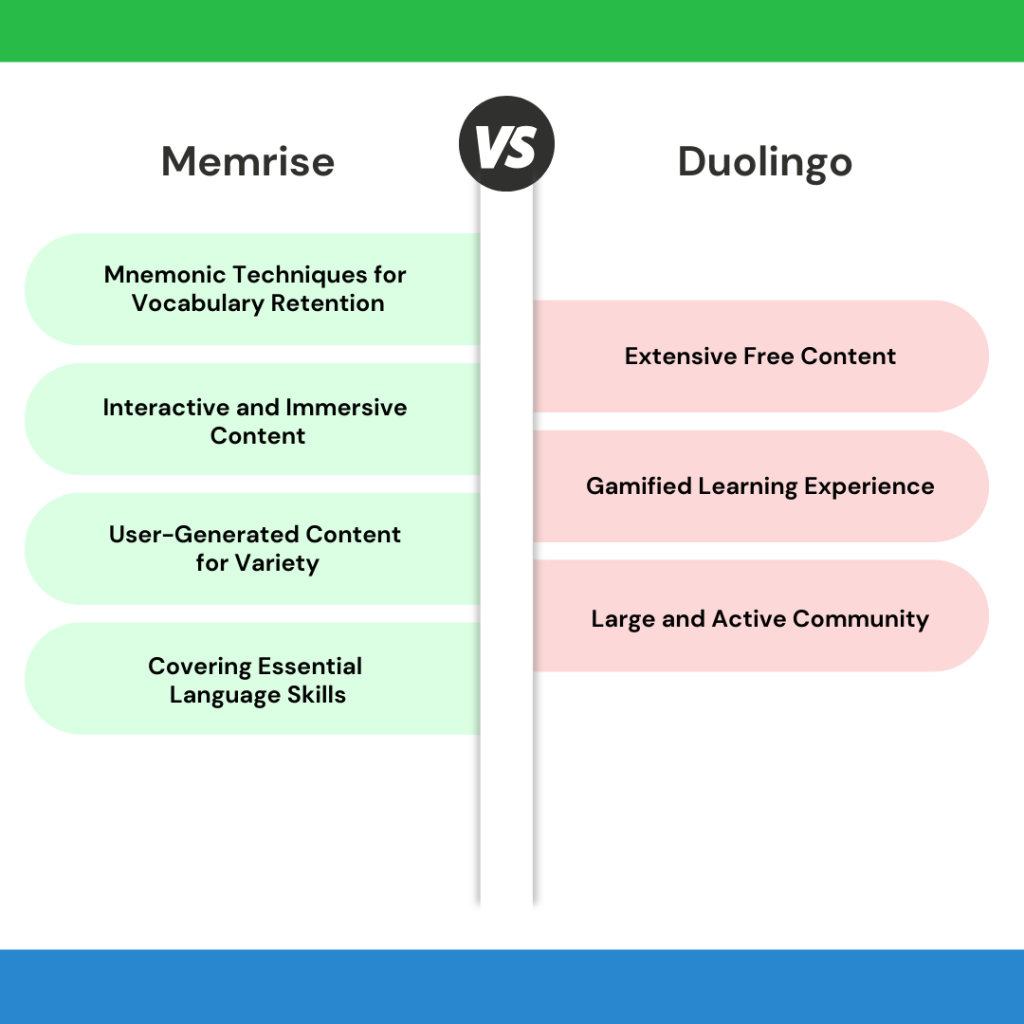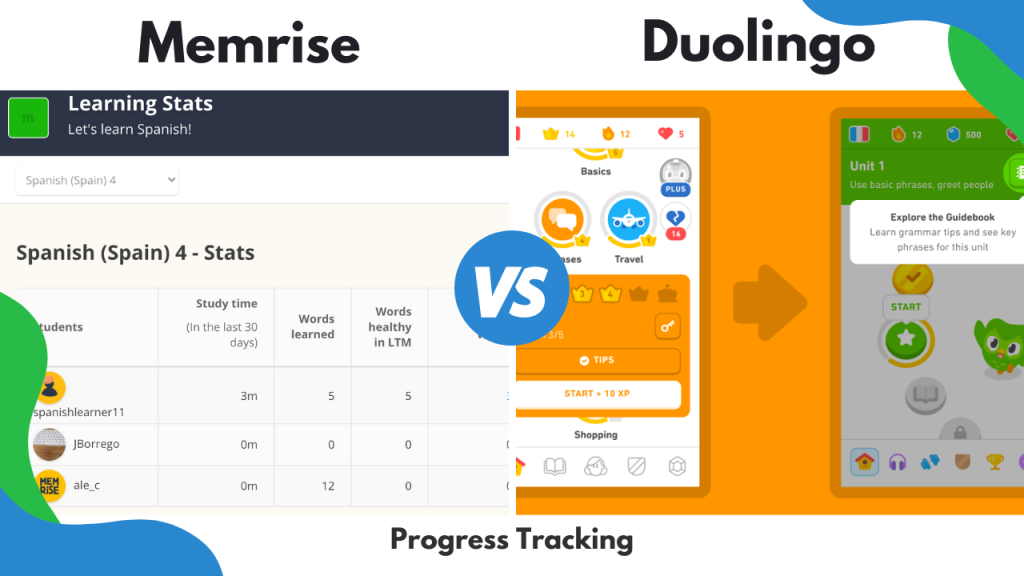
In the language learning apps sector, Memrise and Duolingo have emerged as significant contenders. Memrise distinguishes itself with its innovative use of mnemonic techniques and a focus on vocabulary retention, offering an interactive and engaging platform. Duolingo, on the other hand, is recognized for its gamified approach and diverse language offerings, creating an immersive learning experience.
This article presents a straightforward comparison between Memrise and Duolingo, based on essential factors. From strengths and limitations to pricing structures and teaching methodologies, to provide a comprehensive guide for users interested in language learning apps.

Memrise and Duolingo stand as influential players in the language learning app landscape, each bringing its unique strengths and weaknesses. Let's look into the pros and cons of each platform.
| Pros/Cons | Memrise | Duolingo |
| Pros | Mnemonic Techniques for Vocabulary Retention:These memory aids help users remember and retain vocabulary effectively. Interactive and Immersive Content: The lessons often include real-world scenarios, encouraging practical application of language skills. Covering Essential Language Skills: Including speaking, writing, reading, and listening. The platform aims to enhance users' proficiency in conversations. | Extensive Free Content: Users can engage in language lessons without the need for a financial commitment. Gamified Learning Experience: The platform incorporates game-like elements, such as levels, points, and rewards, making the learning experience enjoyable and motivating. Large and Active Community:Users can participate in forums, discussion groups, and language challenges, creating a sense of community and collaboration. |
| Cons | Pronunciation Challenges: Some users have reported that the pronunciation aspects, especially for less common languages, may not be as robust as other features. Limited Grammar Instruction: While strong on vocabulary, Memrise may have limited emphasis on advanced grammar exercises and professional writing guidance . | Gamification Distraction: Duolingo's gamified approach, while engaging for many, may lead to potential overemphasis on game-like elements. Limited Cultural Immersion: Some users aspiring for a more profound understanding of the culture may find Duolingo's supplementary resources somewhat lacking. |
When it comes to language variety, both Memrise and Duolingo offer a diverse array of options to cater to learners with varied linguistic interests. Memrise provides courses in 22 languages, allowing users to explore both widely spoken and less common ones. Similarly, Duolingo excels in language diversity, offering courses in 41 languages, providing users with a broad spectrum of linguistic choices.
Memrise languages:
Chinese (Mandarin), Danish, Dutch, French, German, Icelandic, Italian, Japanese (Kanji), Japanese (Romaji), Korean, Mongolian, Norwegian, Polish, Portuguese (BR), Portuguese (EU), Russian, Slovenian, Spanish (MX), Spanish, Swedish,Turkish, Yoruba.
Duolingo languages:
Arabic, Catalan, Chinese, Czech, Danish, Dutch, English, Esperanto, Finnish, French, German, Greek, Haitian Creole, Hawaiian, Hebrew, High Valyrian, Hindi, Hungarian, Indonesian, Irish, Italian, Japanese, Klingon, Korean, Latin, Navajo, Norwegian, Polish, Portuguese, Romanian, Russian, Scottish Gaelic, Spanish, Swahili, Swedish, Turkish, Ukrainian, Vietnamese, Welsh, Yiddish, Zulu.

Let's take a closer look at how users interact with language apps like Memrise and Duolingo. This section dives into the practical aspects of interface design, personalization features, and what makes the learning process smooth and engaging.
Memrise and Duolingo offer user-friendly interfaces with distinct design approaches. Memrise is celebrated for its interactive and intuitive design, allowing seamless navigation through mnemonic-based lessons. Duolingo, while also intuitive, adopts a gamified approach that enhances engagement and may pose a learning curve for some users seeking a straightforward path.
Personalization is a key factor in language learning, and both Memrise and Duolingo address this in different ways. Memrise allows users to set personal goals and tailored lessons based on individual progress, focusing on vocabulary retention. Duolingo, with its gamified experience, provides personalization through adaptive challenges, although the free version has limitations in this aspect.
Both Memrise and Duolingo incorporate gamification elements to make language learning more engaging. Memrise's approach involves mnemonic techniques and interactive challenges, promoting motivation through effective vocabulary retention. Duolingo, known for its gamified experience, turns language acquisition into a playful adventure, motivating users through a variety of interactive exercises.

The teaching methods employed by Memrise and Duolingo shape the learning experience for users. Each app brings a distinctive approach to the learning process, from mnemonic-based lessons to gamified exercises.
| Teaching methods | Memrise | Duolingo |
| Methodology | Memrise employs a methodology that centers around mnemonic techniques for vocabulary retention. The platform uses vivid associations, images, and phrases to help users create mental connections and enhance their ability to remember words and phrases. | Duolingo adopts a gamified methodology, turning language learning into a playful and interactive experience. Lessons are designed as bite-sized, interactive challenges, providing a dynamic and engaging approach to language acquisition. |
| Practice Areas | Memrise covers essential language skills, including speaking, writing, reading, and listening. The platform focuses on conversational proficiency, aiming to enhance users' ability to engage in real-life conversations in the target language. | Duolingo covers all fundamental language skills, including vocabulary, grammar, speaking, listening, reading, and writing. The platform includes a variety of exercises, from traditional vocabulary tasks to interactive challenges that feel like mini-games. |
| Use of Native Speakers | Memrise integrates native speakers into its courses, utilizing their voices for pronunciation exercises and real-life dialogues. By incorporating native speakers, Memrise aims to provide users with an authentic experience of language tones, accents, and expressions. | Duolingo also incorporates native speakers into its courses, utilizing their voices for pronunciation exercises and audio components. Exposure to native speakers enhances the authenticity of the language learning experience, helping users develop accurate pronunciation and a natural understanding of language nuances. |
Understanding the pricing models and the value they offer is essential for users making informed choices. Let’s see the financial aspect of Memrise and Duolingo, exploring the differences in their free and premium versions.
Both Memrise and Duolingo offer both free and premium versions, each with distinct features. Memrise provides users with a taste of its mnemonic-based lessons for free, but to access advanced features and additional content, a subscription is required. Duolingo is renowned for its extensive free content, allowing users to engage in language learning without a financial commitment. The free version of Duolingo includes a broad range of features, making it accessible to a large audience.
For users opting for premium features, the subscription costs for Memrise and Duolingo differ. Memrise operates on a subscription model, where users pay a recurring fee to access premium content and features. Duolingo also offers a premium subscription, providing an ad-free experience and additional features. The cost structures of these subscriptions cater to diverse user preferences and budget considerations.
| Memrise | Duolingo |
| Basic plan: Free Pro Monthly: $14.99 Pro Annual: $ 89.99 Lifetime: $ 199,99 | Basic plan: Free Super Duolingo Monthly: $12.99 Super Duolingo Yearly: $ 83.99 |

The effective progress tracking becomes a fundamental guide for learners to understand their linguistic process. This section looks into how Memrise and Duolingo empower users to monitor and enhance their language skills.
Both Memrise and Duolingo provide users with dashboards and statistics to monitor their language learning progress effectively. Memrise's dashboard offers a clear snapshot of completed lessons, ongoing activities, and achievements, ensuring users have a comprehensive overview of their learning journey. Duolingo, with its user-friendly dashboard, visually presents progress and celebrates milestones, fostering motivation.
Both platforms enable users to track the mastery of language skills, albeit with slightly different approaches. Memrise employs a mnemonic-based system, ensuring users reinforce learned material, enhancing retention. Duolingo utilizes an adaptive learning system, adjusting exercises based on user performance to focus on areas that may need additional attention.
Memrise and Duolingo recognize the importance of flexibility in learning environments. Memrise allows users to download lessons for offline use, ensuring accessibility even without an internet connection. Duolingo offers a similar offline mode, allowing users to continue their language learning seamlessly, whether they are on a plane or in a location with limited connectivity.
Beyond structured lessons, language learners often find value in additional resources that offer a more immersive and varied experience. This section explores how both Memrise and Duolingo go the extra mile by providing supplementary content.
Memrise extends its offerings to include additional learning content, such as video clips, grammar explanations, phrasebooks and a blog, providing users with a more comprehensive understanding of the language. Duolingo, while primarily known for its gamified exercises, also incorporates diverse content, including stories and cultural insights in podcasts and blogs, enhancing the overall learning experience.
Both platforms recognize the value of community support in language acquisition. Memrise fosters a sense of community through forums and discussion groups, allowing users to interact, share experiences, and seek advice. Duolingo, with its large and active user base, thrives on community-driven learning, encouraging users to connect, share insights, and practice languages together.
As we compare the main features of Memrise and Duolingo, it's essential to recap the main differences and similarities. Memrise, with its mnemonic-based approach and interactive content, provides a unique method for effective vocabulary retention. Duolingo, renowned for its gamified experience and extensive free content, offers an engaging and diverse language learning process.
Choosing between Memrise and Duolingo ultimately depends on individual preferences and learning styles. For learners valuing an interactive and mnemonic-focused approach, Memrise may be the preferred choice. On the other hand, those who thrive in a gamified environment with a large and vibrant community might find Duolingo more appealing. Regardless of the choice, both apps offer valuable tools to start a great language learning experience.
Which app is more cost-effective?
Both Memrise and Duolingo offer free versions, catering to a wide audience. Duolingo is renowned for its extensive free content, while Memrise's subscription model provides additional features for a fee. The choice between cost-effectiveness and premium features depends on individual preferences and budget considerations.
Are there notable differences in teaching methods?
Yes, there are distinct differences. Memrise emphasizes mnemonic-based vocabulary retention, while Duolingo employs a gamified methodology. The choice between these approaches depends on the learner's preference for a more traditional or interactive learning experience.
Can I learn less common languages on these apps?
Both Memrise and Duolingo offer a variety of languages, including some less commonly learned ones. However, the availability may vary, so it's advisable to check the language options on each platform to ensure they align with your learning goals.
How do these apps track progress, and is it effective?
Both apps provide dashboards and statistics to track progress effectively. Memrise's mnemonic-based system and Duolingo's adaptive learning mechanism contribute to a comprehensive understanding of the user's language proficiency.
Which app provides better community support for learning?
Duolingo is recognized for its large and active community, fostering social learning through forums and discussion groups. Memrise, while emphasizing individualized learning, also offers community interaction opportunities, although to a lesser extent.
How do Memrise and Duolingo handle cultural immersion in their supplementary resources?
Both apps incorporate supplementary resources like podcasts, phrasebooks, blogs and videos to enhance cultural immersion. Memrise and Duolingo aim to provide users with insights into the cultural aspects of the languages they are learning, offering a more holistic language experience.
How do Memrise and Duolingo address individual learning paces and skill levels?
Both platforms cater to individual learning paces. Memrise tailors lessons based on individual progress, focusing on vocabulary retention. Duolingo's adaptive learning adjusts exercises based on performance, ensuring a personalized learning experience for users with varying skill levels.
Are there age restrictions or specific age groups targeted by Memrise and Duolingo?
Memrise and Duolingo are designed to accommodate learners of various age groups. While they are suitable for adult learners, Duolingo, with its gamified elements, may also appeal to younger audiences. The accessibility and user-friendly interfaces make them versatile options for learners of all ages.